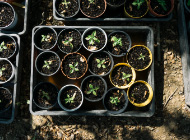
There are many, many different types, shapes and sizes of seeds on our planet. The importance of seeds to sustain green life is very obvious and can’t be stressed enough.
"The land produced vegetation: Plants bearing seed according to their kinds and trees bearing fruit with seed in it according to their kinds. And God saw that it was good".
When it comes to the Nursery and Horticulture Industry, we pay a very important role.. Seeds are the basic necesity for all plants to survive. Seeds contains everything a plant needs for reproducing itself.
This article explores some knowledge about seed coatings, seed sowing and seed handling in the Nursery & Horticulture Industry.
How the seeds are sown largely affects the seed germination rates, quality and consistency of green life. Without good germination conditions, a quality plant can not be grow and eventually sold.
Factors that Contribute to Seed Germination
According to Kamil Pasek, below are the factors that affect seed germination
- Containers
- Humidity
- Temperature
- Planting medium (soil media or mixture)
- Location and light
- Repotting and acclimatisation
- Sowing times
- Lifespan of seeds (freshness)
- Pests, algae and diseases
- Other factors
The conditions above generally will not impact on seed germination unless seeds are sow successfully into the planting medium. In nursery practices, sowing seeds into the soil mixture can be a real challenge.
Why is Sowing Seeds not an easy task for Nurseries?
- Depending on the nursery size and the seedling demand, if the seeds are sown manually, quality and consistency issues along with high manual labour costs could be incurred.
- If seeds haven’t been coated (also known as pelleting), seeds are in most cases are irregular ly shaped and sized. Uncoated seeds have less chance of being planted with a mechanical seeder into plugs, cells, trays or flats with accuracey.
- Irregular sized and shaped seeds grow with a less uniform stand, more seeds are used, and more time is spent on thinning and pricking out.
- It is important to sow the seed and have them germinate without the seeds drying out, to maximise germination success. However, note: overwatering may restrict the seeds of access to oxygen, again reducing germination success.
- Coated seeds generally should be used within one (1) year of purchase.
So how to solve these problems? The answer is seed treatment and seed automation
1.Seeds treatment is so crucial to nurseries
According to the article on “Organic Seed Treatment and Coatings”. The reasons to have seed treatment in place is to improve seed propogation rates through the three following ways:
(1) Eliminate or protect from seedborne disease pathogens
(2) Enable easy handling and makes planting spacing more accurate (no uneven spacing or gaps in plant spacings reducing the demand for thinning of seedlings). Idea conditions for mechanical seeders.
(3) Improve germination rates and consistent quality which is the ultimate goal.
Different type of seed treatment exists which include mechanical treatment, soakng in cold water, soaking in hot or boiling water, acid treatments etc. See inoculation and other treatments.
Seed Coating (Palleting) is a coating for seed which is usually comprised of different density fertilizer or other growth promotors or inert materials which are then covered with a polymer outer shell binder. Seed sizes are consistent but seed weights may vary.
What Is the purpose of pelleting (Seed Coating)?
To change seeds size and shape for improved plantability. To achieve higher "seed to vaccum hole" ratios on planting drums.
According to seed dynamics, seeds are:
First of all, with seed coating, irregular shaped seeds with different shapes, sizes and weight can be made consistent. All small, irregularly shaped/non-round seed such as lettuce carrots, onions, herbs and flowers can become uniform and treated as larger, round-shaped seed thanks to pelleting.
Secondly, pelleting helps singulating seeds and planting them in accurate rows. In other words, uniformed round coated seeds can be sow accurately and precisely by a machine.
Thirdly, pelleting makes easier, safer, and more accurate and achievable the mechanical seeding process, hence its reduces gaps and inconsistency in trays and the requirement for labor intensive thinning and pricking out.
Wholesale nurseries usually sow seeds in large volume, so how are seeds sown in an effective and efficient way? See answer below
2. Use of seeding machines to automate the seed sowing process
Wholesale nurseries are known as a labor intense industry because of the variety of activities to be carried out in volume during the daily operation. There is complexities of seedling and plant propogation as well as the material handling processes. Higher labor cost is a major concern of a nursery manager and nursery business owner.
When it comes to sowing seed, a seeder can greatly automate the tedious manual seed sowing process and save lots of cost in labor. There are quite a few other benefits when using a seedling machine/seeder to sow seeds.
A seeder ensures:
- Sowing speed: Speed has a huge impact on the sowing quality and yield potential. It influences the distribution of seeds and depth of seed deposition.
- Control accuracy: A seeder is able to distribute seeds of irregular shape with greater precision due to its automatic and mechanical controlled system;
- Decrease in the occurrence of skips, and decreases the mechanical injury of seeds;
- Uniform spacing between seeds;
Conclusion
Seed sowing must be well planned and executed because it is not only an essential step at the beginning of the production process, but also one of the key factors that influences the success of germination, plant growth, quality and productivity.
There are many factors that affect seed germination! The specific seed treatment of "seed coating" (pelleting) and the utilisation of seeding equipment can greatly improve the process of sowing seeds and provide a rapid and uniform plant along with consistent quality that can be repeatedly assured.








